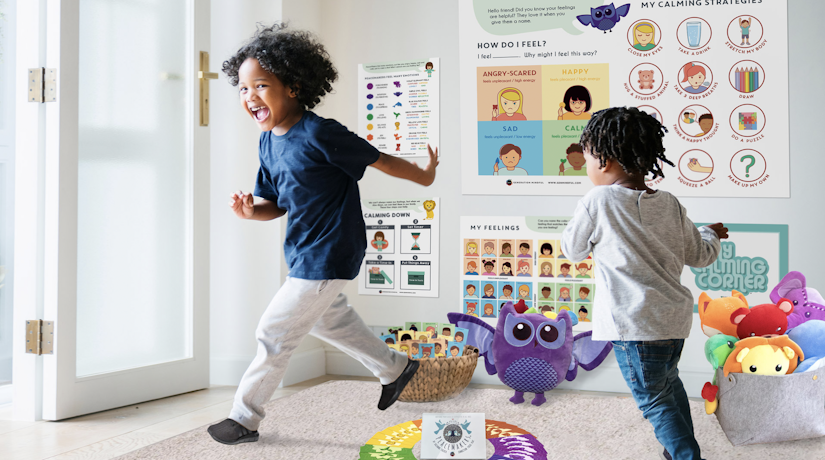
How To Use The Time-In ToolKit® To Teach Kids About Emotions
Use Time-Ins and a calming space to help kids playfully learn how to name and regulate their emotions.

What's The Time-In ToolKit?
Children can be taught social and emotional skills in much the same way we teach them to read and write. The Time-In ToolKit® is a guided resource that nurtures social and emotional skills by engaging adults and children in mindful, affirming conversation about the many feelings we all experience.
While time-outs are traditionally punitive experiences that isolate the child for a set amount of time as determined by the adult, Time-Ins are a way to help children learn to calm their bodies and process emotions in a safe space (aka Calming Corner™) so that they can problem-solve, learn and grow.
Time-Ins empower children to check in with their bodies when they are feeling strong emotions so that they can respond to situations rather than react. When children feel safe, and connected, they have a much easier time learning new skills.
Who is The Time-In ToolKit for?
Our world-famous Time-In ToolKit can be used by parents, caregivers, therapists, teachers, daycare providers, and grandparents; anyone committed to teaching and guiding children by example using connection, redirection, and loving discipline.
What's Included in The Time-In ToolKit?
The Time-In ToolKit includes six posters, (3) 8"x10", (1) 12" x 16" and (2) 20" x 30," (1) deck of PeaceMakers Affirmation Cards, (1) Time-In Activity Mat, and (2) sets of My Feelings Faces & Calming Strategy cards. If you choose to frame your posters, we recommend IKEA frames for quality and price.
Want to save 20% on your ToolKit purchase? Check out our new Calming Corner Bundle!
Set Up Your Calming Corner
It's time to assemble your Calming Corner space! Walk around with your child/children to see where they feel most comfortable and allow them to help choose the space. You can even make this a fun game!
Pretend to be explorers looking for the perfect space for your Calming Corner. Ideally, this is an area (possibly a corner) of your home, classroom, or office where you can devote 3-5 ft. of wall space to hang or store your posters and Time-In activities.
Emotional Intelligence In Action
The ToolKit will equip you with practical tools to teach emotional intelligence and foster listening, cooperation, connection, and self-control. We say "Name it to tame it...Feel it to heal it!" Check out the videos below to see how other families are transforming challenging behaviors and making learning about emotions FUN for tots to tweens!
Name It
Start Early
Emotional intelligence begins in infancy when babies bond with caregivers and learn that people will respond to them when they cry or smile. As your baby grows, he or she will become more aware of emotions, gaining the ability to name them, respond to them, and eventually regulate them.
The first step in developing emotional intelligence at any age is the practice of recognizing our emotions. It’s not until a child can identify emotions and respond to the feelings of others that she can also begin to control her own feelings. This may seem like a tall order for a 2-year-old, but studies show that even babies as young as 18 months can recognize and respond to emotions.
Name Feelings
“Grumpy is her new word. Just wanted to share that the Time-In ToolKit works for 2 yr olds!” - Regina, Mom of 2 yo using Time-in ToolKit
When our kids are small and trying to manage emotions - they can't express what they are feeling. They throw tantrums, they throw things, they have meltdowns, they scream, and they whine. This is their way of communicating with us. They need help to
organize, process, and express their feelings in healthy ways. We can teach them these skills instead of punishing them, putting them in time-out, etc.
Understand Feelings
Our thoughts and actions are shaped by our many feelings and experiences. Making time to explore and understand our feelings through our many senses including movement, listening, and meaningful dialogue connects us. We are creating a world that gives all human beings (especially young children) permission to feel. How much less violence and mental health challenges would we see if every child was raised to feel seen, heard, and a sense of belonging? That's the world we are creating using Time-In's.
Feel It
Create Connections
Instead of hitting her mom, or hitting her dog, this sweet 4 yo girl (who has been struggling with impulse control issues and managing her feelings since her parents separated) was able to notice that she was feeling nervous AND to name and share her feelings with her mama using her SnuggleBuddies plush, Yellow Lion. Snugglebuddies Emotions Plush toys make great additions to your Calming Corner!
She named all four moods, happy (yellow), sad (blue), calm (green), and mad (red) using the toy's mood emojis ... instead of lashing out.
This is what self-awareness, self-control, and compassion look like in the making. When we model self-love and forgiveness, children learn self-love and forgiveness.
Prevent Sibling Rivalry
Sharing and naming emotions fosters healthy relationships, reducing family tension. Simply listening and validating each family member’s experience is the first step to teaching children the important life skill of conflict resolution.
Time-Ins for Tots to Tweens
When your child is feeling overwhelmed, what do they do? 10-year-old Meghan has some ideas on this.
Children as old as 9, 10, and 11 are benefiting from the Time-In ToolKit®.
Emotional intelligence starts with naming our emotions, but it doesn’t end there. We can also learn to pause before we act on our thoughts and feelings.
Heal It
Make Amends
As parents, we can nurture kindness in our children. “It’s kind of like weight training,” says Dr. Ritchie Davidson from the University of Wisconsin. “We found that people can build up their compassion ‘muscle’ and respond to others’ suffering with care and a desire to help.”
When children are given the choice to share, apologize, or offer kind gestures instead of being forced to, they are roughly twice as likely to be generous later. And when kids are praised and recognized for their kindness, they are more likely to help again. The Time-In ToolKit does both.
Use What You Learn
Being able to name feelings and the cause behind big emotions is the first step towards building resilience and healthy ways to cope with situations. The video below shows children putting the skills they've learned with their ToolKit into action.
Create Healthy Habits
“I am safe and secure.” That’s the Red Bear 🐻 PeaceMakers card this three years old pulled to talk about with her mom before bedtime. Watch as she tells her mom what it feels like when she feels safe... versus when she feels scared.
This sweet girl has been using the Time-In Toolkit® (Family Bundle) for just 2 months to help with her bedtime routine! Her mama tells us she LOVES it and has gone from, at one point, having 33 tantrums in a day (that's a lot...) to just one in a week.
The Ultimate Guide To Building A Calming Corner & Using Time-ins At Home & School
The Ultimate Guide To Building A Calming Corner And Using Time-Ins At Home
How do you say goodbye to time-outs and introduce time-ins? This is the ultimate guide on the do's and don'ts for building and using a Calming Corner.

Share







